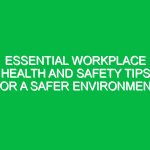Understanding Health Hazards in the Workplace
A health hazard is defined as any condition, substance, or situation that can cause injury, illness, or adverse health effects to workers. In the realm of Health, Safety, and Environment (HSE), recognizing and managing health hazards is essential for creating safe workplaces. These hazards can range from chemical exposure to ergonomic issues, and they can significantly impact employees’ well-being and productivity.
In this article, we will delve into one of the most pressing health hazards faced in various industries: chemical exposure. By understanding the complexities surrounding this hazard, we can unlock vital secrets to enhance workplace safety.
Defining Chemical Exposure as a Health Hazard
Chemical exposure occurs when an individual comes into contact with hazardous substances. These substances can be found in various forms: solids, liquids, or gases, and they can permeate the air we breathe, the surfaces we touch, or the materials we work with. The implications of prolonged exposure can be severe, leading to respiratory diseases, skin irritations, and even cancer.
In a study published by the National Institute for Occupational Safety and Health (NIOSH), it was reported that nearly 13 million workers in the United States are potentially exposed to hazardous chemicals in their workplaces. The risks associated with chemical exposure can vary depending on the type of chemical, the duration of exposure, and the level of concentration in the environment.
Key Aspects of Chemical Hazards
When addressing chemical hazards, it’s essential to understand the different categories of chemicals that can pose risks:
- Toxic Chemicals: Substances that can cause harm to human health when inhaled, ingested, or absorbed through the skin.
- Corrosive Chemicals: Materials that can destroy living tissue or severely corrode materials through chemical reactions.
- Flammable Chemicals: Substances that can easily ignite and cause fire or explosions.
- Reactive Chemicals: Chemicals that can react violently when exposed to certain conditions or other substances.
Understanding these classifications is crucial for developing risk management strategies and ensuring comprehensive safety protocols.
Identifying the Risks of Chemical Exposure
The risks associated with chemical exposure are multifaceted. Some of the common health issues linked to chemical exposure include:
- Respiratory Problems: Inhalation of toxic fumes can lead to chronic respiratory diseases such as asthma and chronic obstructive pulmonary disease (COPD).
- Skin Disorders: Direct contact with corrosive or irritant chemicals can cause dermatitis, burns, or allergic reactions.
- Cancer: Long-term exposure to certain carcinogenic substances can increase the risk of developing cancer.
Moreover, the psychological impact of working in hazardous environments cannot be overlooked. Workers may experience anxiety and stress, affecting their overall mental health and workplace productivity.
Best Practices for Mitigating Chemical Exposure
To effectively manage the risks associated with chemical exposure, organizations must implement a series of best practices:
- Risk Assessment: Conduct regular assessments to identify potential chemical hazards in the workplace.
- Proper Labeling: Ensure all chemicals are correctly labeled with hazard symbols and safety information.
- Personal Protective Equipment (PPE): Provide appropriate PPE such as gloves, goggles, and respirators to minimize exposure.
- Training and Education: Offer training sessions for employees on the safe handling and disposal of hazardous chemicals.
- Ventilation Systems: Install proper ventilation systems to reduce airborne contaminant levels.
Implementing these practices not only protects employees but also fosters a culture of safety within the organization.
Regulations and Standards Governing Chemical Exposure
Various regulations govern the handling and exposure to hazardous chemicals in the workplace. The Occupational Safety and Health Administration (OSHA) has established guidelines that require employers to:
- Provide a safe working environment.
- Train employees on the hazards of chemicals they may encounter.
- Ensure proper labeling and Material Safety Data Sheets (MSDS) are available.
These regulations are crucial for enforcing compliance and protecting workers from the adverse effects of chemical exposure.
Real-Life Examples of Chemical Exposure Incidents
Understanding the gravity of chemical exposure can be illuminated through real-life examples. One notable case is the 2014 chemical spill in West Virginia, where a toxic chemical leaked into the water supply, affecting thousands of residents and workers. This incident highlighted the importance of stringent safety protocols and quick response measures in crisis situations.
Another example can be found in the manufacturing sector, where workers may be exposed to solvents and other chemicals daily. A company that implemented a comprehensive safety program, including mandatory PPE and regular training, saw a significant reduction in workplace accidents and health-related absences.
Creating a Culture of Safety
Beyond compliance with regulations, fostering a culture of safety is paramount in minimizing health hazards. This involves encouraging open communication where employees feel empowered to report unsafe conditions without fear of retaliation. Regular safety drills, feedback loops, and recognizing safety accomplishments can bolster this culture and keep safety at the forefront of employees’ minds.
Conclusion: The Path Forward
In conclusion, chemical exposure remains a critical health hazard within the HSE domain. By understanding its complexities and implementing effective mitigation strategies, organizations can safeguard their workforce and promote a healthier, safer working environment. The journey towards workplace safety requires diligence, training, and a commitment to continuous improvement.
As we move forward, let us prioritize health and safety, not just as regulatory obligations, but as fundamental ethics that protect our most valuable asset—our people. Embracing these principles can lead to enhanced productivity, employee satisfaction, and ultimately, a more sustainable future.


